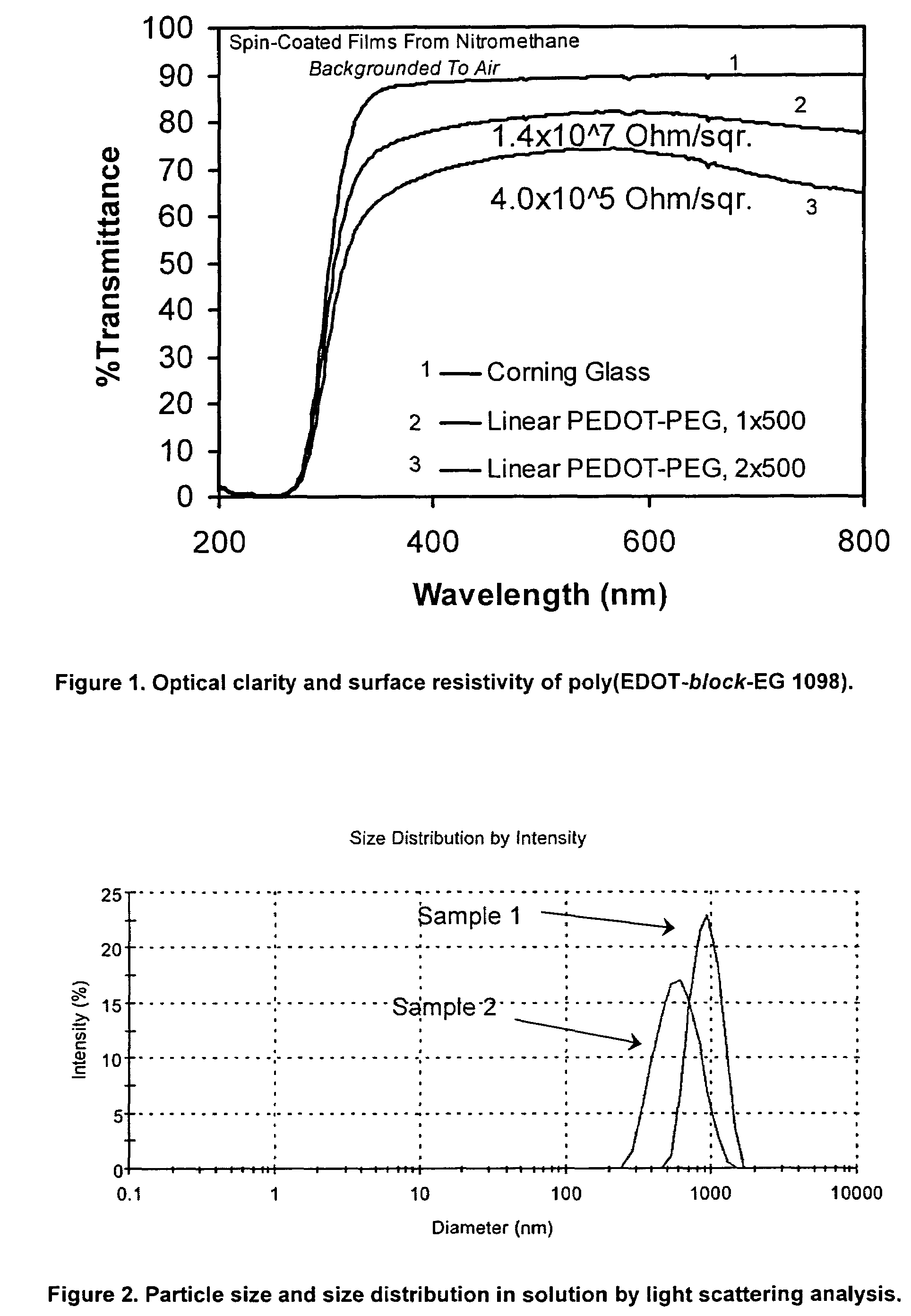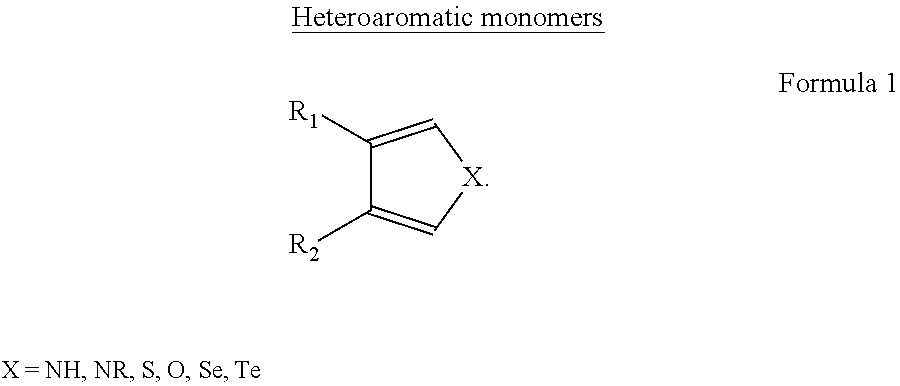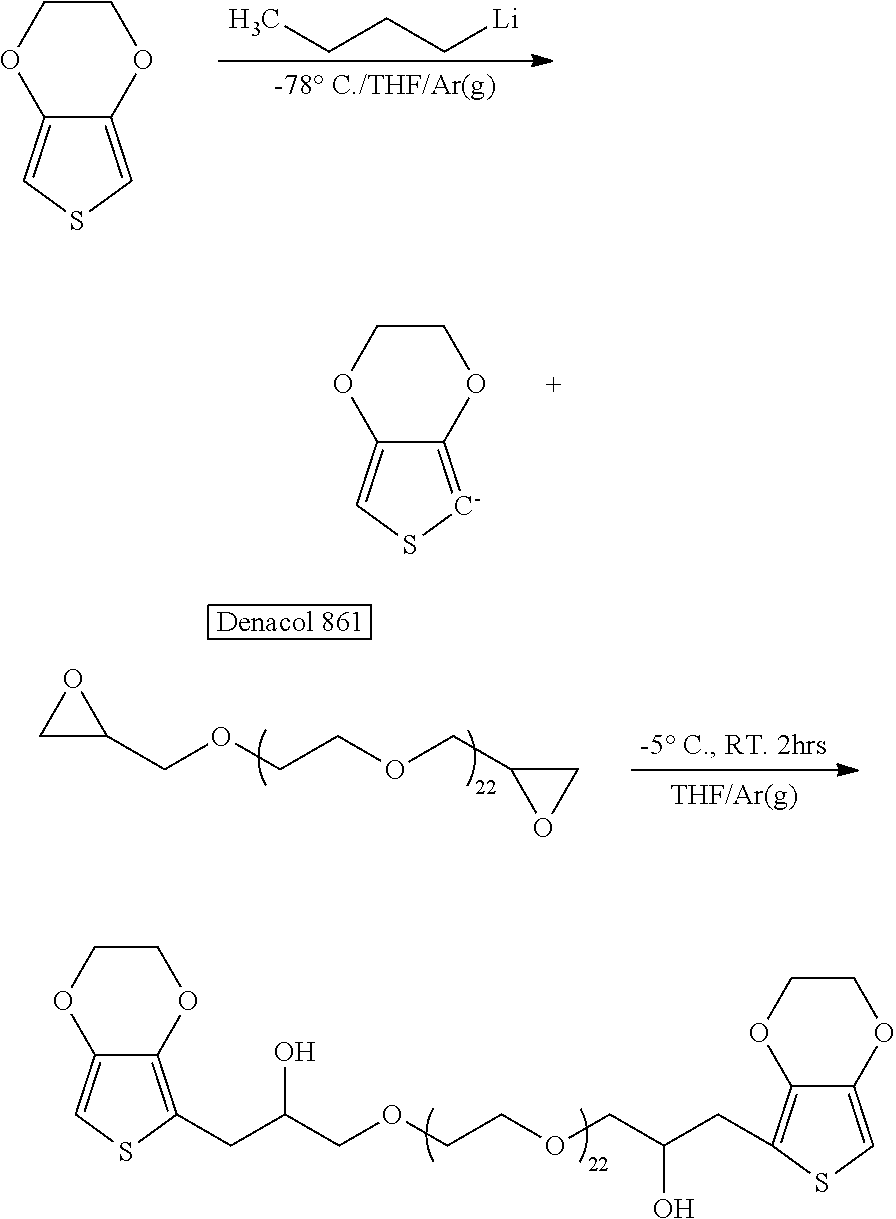Methods of production, purification, and processing of poly(heteroaromatic) block copolymers with improved solubility or dispersability
a technology of polyheteroaromatic and solubility, applied in the field of production, purification and processing of polyheteroaromatic block copolymers with can solve the problems of undesirable gel formation in the icp composition for thin film formation, inability to be processed, and inability to oxidize or dop heteroaromatic icp, etc., to achieve improved solubility or dispersibility, improve the effect of polymer
- Summary
- Abstract
- Description
- Claims
- Application Information
AI Technical Summary
Benefits of technology
Problems solved by technology
Method used
Image
Examples
example 1
Production and Purification of poly(EDOT-block-EG 1098) (ABAB-Type Multi-Block Copolymer)
Synthesis of di-EDOT-Terminated Polymeric Block (PEG1098dEDOT)
[0083]
[0084]3,4-Ethylenedioxythiophene (EDOT, 7.15 g, 0.05 mol, 1 eq) in 150 mL of tetrahydrofuran (THF) was added to an oven dried 3-neck round bottom flask and cooled in an isopropanol / liquid nitrogen bath. An oven dried glass syringe was flashed with argon until cool, then used to transfer 20 mL of 2.5 M n-butyllithium (0.05 mol, 1 eq) to the stirring solution, the color of which changed to pale yellow after the addition of n-butyllithium. The stirred mixture was allowed to warm up to −10 deg.C. Meanwhile, Denacol 861 (Nagase Corporation, 6.86 g 0.00625 mol, 0.125 eq) was purged with argon, then dissolved with ca. 30 mL of THF under stirring and / or sonication. The Denacol solution was transferred to a dropping funnel via cannula and added slowly to the reaction flask at 5 deg.C. The mixture was stirred for ca. 2.5 hours at room tem...
example 2
Production and Purification of poly(EDOT-block-EG 1098) (ABAB-Type Multi-Block Copolymer)
[0087]Iron(III) perchlorate hydrate (15.09 g, 43 mmol, violet crystals) was dissolved
[0088]
in 426 mL of acetonitrile (0.1 M solution) in a 1000 mL Erlenmeyer flask to form an oxidant solution. The monomer EDOT (2.04 g, 14.4 mmol) and PEG1098dEDOT (4.02 g) were mixed in a vial and diluted with 15 mL of acetonitrile. This monomer mixture was then added to the stirring oxidant solution. The vial was rinsed with acetonitrile and added to the reaction mixture. The color of the mixture changed immediately from reddish-orange to blue. After allowing this mixture to react for 72 hours at room temperature, the product was isolated and purified by centrifuging the crude copolymerization mixture at 2400 RPM for 7 minutes. The centrifugation was followed by decanting supernatant from the gel formed and washing the gel with acetonitrile and forming a new suspension that was again centrifuged. This process wa...
example 3
Production and Purification of C12PEG870-poly(block-EDOT)-C12PEG870 (BAB-Type Tri-Block Copolymer)
Synthesis of mono-EDOT-Terminated Polymeric Block (C12PEG870-EDOT)
[0089]
[0090]Under argon, EDOT (10.65 g, 75 mmol) was diluted in 200 mL of anhydrous THF and cooled using an isopropanol / liquid nitrogen slurry. N-butyllithium (30 mL, 75 mmol) was added slowly to this cooled mixture. Decacol Ex-171 (8.156 g, 9.37 mmol) was dissolved first with ca. 35 mL THF, then added dropwise to the lithiated EDOT at −10° C. The mixture was stirred in the cold-bath for 2 hours, and then was allowed to come to room temperature with continued stirring overnight. The reaction was quenched with cold 1 M HCl. The organic solvent was reduced under vacuum, and extracted with dichloromethane 3 times. These organic phases were combined and washed with 0.1 M HCl 3 times, then DI water for the final rinse. The washed organic layer was dried over anhydrous magnesium sulfate, and then the solvent was removed under v...
PUM
| Property | Measurement | Unit |
|---|---|---|
| surface roughness | aaaaa | aaaaa |
| number average particle size | aaaaa | aaaaa |
| surface roughness | aaaaa | aaaaa |
Abstract
Description
Claims
Application Information
 Login to View More
Login to View More - R&D
- Intellectual Property
- Life Sciences
- Materials
- Tech Scout
- Unparalleled Data Quality
- Higher Quality Content
- 60% Fewer Hallucinations
Browse by: Latest US Patents, China's latest patents, Technical Efficacy Thesaurus, Application Domain, Technology Topic, Popular Technical Reports.
© 2025 PatSnap. All rights reserved.Legal|Privacy policy|Modern Slavery Act Transparency Statement|Sitemap|About US| Contact US: help@patsnap.com



